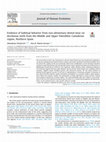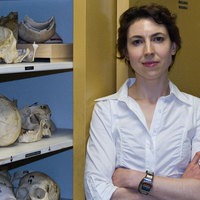Conference Presentations by Almudena Estalrrich

Molar macrowear is a cumulative process which occurs during the individuals’ lifetime. Its study ... more Molar macrowear is a cumulative process which occurs during the individuals’ lifetime. Its study provides strong insights into long term dietary and dental behavior. In this study we analyze the occlusal macrowear pattern by applying the Occlusal Fingerprint Analysis (OFA) method to reconstruct the wear facet distribution and occlusal pathways on the maxillary first and second molars (both right and left) from 11 Neandertal individuals from El Sidrón cave in Northern Spain [1], and place the individuals in the context of other Neandertals previously published [2]. Wear facets on the occlusal surface of molar crowns were quantified from digitized high-resolution casts, and functional parameters such as the area, orientation, and inclination were measured. 3-D occlusal dental compasses of single molars indicate major movements during mastication [3]. The relative facet areas show that the overall power stroke pattern of the group is characterized by a dominance of buccal and lingual Phase I, whereas Phase II is less developed. In this respect the macrowear pattern is similar to that of other Neandertals characterized as mixed diet consumers who occupied deciduous woodland habitats [2]. This is expected since paleoenvironmental reconstruction from the El Sidrón deposits suggests a temperate phase of Marine Isotope Stage (MIS) 3, with temperate Atlantic oceanic conditions, and a mix of both coniferous and deciduous forests with some meadows. Moreover, all adult and sub-adult individuals from the group, reflect a common occlusion pattern with a prevalence of vertical motion, indicating no ontogenetic changes within this familial group on the overall dental food processing. The results here presented are part of a multidisciplinary approach to the reconstruction of the paleodiet and den- tal behavior on the El Sidrón Neandertals, and complement the previous studies based on the analysis of dental calculus [4] and dental microwear [5], and enlarge the dietary signals variability within Neandertals with a mixed diet.
articles by Almudena Estalrrich

A new collection of 49,000 year old Neandertal fossil humeri from the El Sidrón cave site (Asturi... more A new collection of 49,000 year old Neandertal fossil humeri from the El Sidrón cave site (Asturias, Spain) is presented. A total of 49 humeral remains were recovered, representing 10 left and 8 right humeri from adults, adolescents, and a juvenile (not included in the analyses). 3D geometric morphometric (GM) methods as well as classic anthropological variables were employed to conduct a broad comparative analysis by means of mean centroid size and shape comparisons, principal components analysis, and cluster studies. Due to the fragmentary nature of the fossils, comparisons were organized in independent analyses according to different humeral portions: distal epiphysis, diaphysis, proximal epiphysis, and the complete humerus. From a multivariate viewpoint, 3D-GM analyses revealed major differences among taxonomic groups, supporting the value of the humerus in systematic classification. Notably, the Australopithecus anamensis (KP-271) and Homo ergaster Nariokotome (KNM-WT 15000) distal humerus consistently clusters close to those of modern humans, which may imply a primitive condition for Homo sapiens morphology. Australopithecus specimens show a high degree of dispersion in the morphospace. The El Sidrón sample perfectly fits into the classic Neandertal pattern, previously described as having a relatively wide olecranon fossa, as well as thin lateral and medial distodorsal pillars. These characteristics were also typical of the Sima de los Huesos (Atapuerca) sample, African mid-Pleistocene Bodo specimen, and Lower Pleistocene TD6-Atapuerca remains and may be considered as a derived state. Finally, we hypothesize that most of the features thought to be different between Neandertals and modern humans might be associated with structural differences in the pectoral girdle and shoulder joint.

Here, we present the analysis of occlusal molar microwear textures of eight individuals from the ... more Here, we present the analysis of occlusal molar microwear textures of eight individuals from the El Sidrón Neandertal group (Spain). The aims of the study were: 1) to document potential age-, sex-, and maternal lineage-related differences in diet within a Neandertal familial group, and 2) to place the diet of El Sidrón individuals in the context of those of other Neandertal groups. This study also offers an interpretation of the diet of the El Sidrón Neandertals by comparing their microwear signatures to those of recent hunter-gatherer populations with diverse but known diets. The intra-group examination of the microwear signatures are consistent with the females of the El Sidrón group having had more abrasive diets or having used their teeth in more para-masticatory activities than did the males. Aside from the potential sex-related differences in diet, no additional intra-group dietary separation, such as by age group or maternal lineage, was observed. In comparison to other Neandertals, El Sidrón individuals, as a group, have microwear signatures most similar to those of other Neandertals from wooded habitats and different from those that lived in more open habitats. This result is expected based on the available paleoenvironmental reconstructions from El Sidrón Cave. The diet of the El Sidrón Neandertals, just like their Neandertal counterparts from similar wooded habitats, is interpreted as having been mixed, consisting of both meat and vegetable foods.

The study of the Neanderthal thorax has attracted the attention of the scientific community for m... more The study of the Neanderthal thorax has attracted the attention of the scientific community for more than a century. It is agreed that Neanderthals have a more capacious thorax than modern humans, but whether this was caused by a medio-lateral or an antero-posterior expansion of the thorax is still debated, and is key to understanding breathing biomechanics and body shape in Neanderthals. The fragile nature of ribs, the metameric structure of the thorax and difficulties in quantifying thorax morphology all contribute to uncertainty regarding precise aspects of Neanderthal thoracic shape. The El Sidrón site has yielded costal remains from the upper to the lower thorax, as well as several proximal rib ends (frequently missing in the Neanderthal record), which help to shed light on Neanderthal thorax shape. We compared the El Sidrón costal elements with ribs from recent modern humans as well as with fossil modern humans and other Neanderthals through traditional morphometric methods and 3D geometric morphometrics, combined with missing data estimation and virtual reconstruction (at the 1st, 5th and 11th costal levels). Our results show that Neanderthals have larger rib heads and articular tubercles than their modern human counterparts. Neanderthal 1st ribs are smaller than in modern humans, whereas 5th and 11th ribs are considerably larger. When we articulated mean ribs (size and shape) with their corresponding vertebral elements, we observed that compared to modern humans the Neanderthal thorax is medio-laterally expanded at every level, especially at T5 and T11. Therefore, in the light of evidence from the El Sidrón costal remains, we hypothesize that the volumetric expansion of the Neanderthal thorax proposed by previous authors would mainly be produced by a medio-lateral expansion of the thorax. Resumen El estudio del tórax Neandertal ha atraído el interés de la comunidad científica por más de un siglo. Existe acuerdo acerca de la mayor capacidad torácica en Neandertales en comparación con humanos modernos. Sin embargo, si esto es causado por una expansión antero-posterior o medio-lateral del tórax es debatido a día de hoy y es clave para el entendimiento de la biomecánica respiratoria y la morfología corporal en Neandertales. La frágil naturaleza de las costillas, la estructura metamérica del tórax y las dificultades en la cuantificación morfológica contribuyen a la incertidumbre en referencia a aspectos de la morfología torácica Neandertal. El yacimiento de El Sidrón ha proporcionado elementos costales que comprenden desde el tórax superior hasta el inferior, así como diferentes restos costales proximales (frecuentemente ausentes en el registro fósil Neandertal), los cuales pueden arrojar luz sobre esta incertidumbre. Nosotros comparamos las costillas de El Sidrón con costillas de humanos modernos actuales, así como con humanos modernos fósiles y otros Neandertales, a través de técnicas de morfometría clásica y morfometría geométrica 3D, combinadas con técnicas de estimación de datos perdidos y de reconstrucción virtual (a nivel de 1a, 5a y 11a costilla). Nuestros resultados muestran que los Neandertales presentan cabezas costales y tubérculos articulares más grandes que humanos modernos. A nivel de tamaño global de las costillas, las 1a costillas Neandertales son más pequeñas que las de humanos modernos, mientras que las 5a y 11a son considerablemente más grandes. Cuando articulamos costillas medias (forma y tamaño) con sus correspondientes elementos vertebrales, nosotros observamos que el tórax Neandertal presenta una expansión medio-lateral en los diferentes niveles estudiados con respecto a humanos modernos, aunque esto es más evidente a nivel T5 y T11. Por lo tanto, a la luz de la evidencia proporcionada por los restos costales de El Sidrón, nosotros hipotetizamos que la expansión volumétrica Neandertal propuesta por autores previos, debería ser fundamentalmente producida por una expansión medio-lateral del tórax.

Two Neandertal specimens from El Sidrón, northern Spain, show evidence of retained left mandibula... more Two Neandertal specimens from El Sidrón, northern Spain, show evidence of retained left mandibular deciduous canines. These individuals share the same mitochondrial (mtDNA) haplotype, indicating they are maternally related and suggesting a potential heritable basis for these dental anomalies. Radiographs and medical CT scans provide evidence of further, more extensive dental pathology in one of these specimens. An anomalous deciduous canine crown morphology that developed before birth subsequently suffered a fracture of the crown exposing the pulp sometime after eruption into functional occlusion. This led to death of the tooth, periapical granuloma formation and arrested deciduous canine root growth at an estimated age of 2.5 years. At some point the underlying permanent canine tooth became horizontally displaced and came to lie low in the trabecular bone of the mandibular corpus. A dentigerous cyst then developed around the crown. Anterior growth displacement of the mandible continued around the stationary permanent canine, leaving it posteriorly positioned in the mandibular corpus by the end of the growth period beneath the third permanent molar roots, which, in turn, suggests a largely horizontal growth vector. Subsequent longstanding repeated infections of the expanding cyst cavity are evidenced by bouts of bone deposition and resorption of the boundary walls of the cyst cavity. This resulted in the establishment of two permanent bony drainage sinuses, one through the buccal plate of the alveolar bone anteriorly, immediately beneath the infected deciduous canine root, and the other through the buccal plate anterior to the mesial root of the first permanent molar. It is probable that this complicated temporal sequence of dental pathologies had an initial heritable trigger that progressed in an unusually complex way in one of these individuals. During life, this individual may have been largely unaware of this ongoing pathology.

Twenty-nine carpal bones of Homo neanderthalensis have been recovered from the site of El Sidrón ... more Twenty-nine carpal bones of Homo neanderthalensis have been recovered from the site of El Sidrón (Asturias, Spain) during excavations between 1994 and 2009, alongside ∼2500 other Neandertal skeletal elements dated to ∼49,000 years ago. All bones of the wrist are represented, including adult scaphoids (n = 6), lunates (n = 2), triquetra (n = 4), pisiforms (n = 2), trapezia (n = 2), trapezoids (n = 5), capitates (n = 5), and hamates (n = 2), as well as one fragmentary and possibly juvenile scaphoid. Several of these carpals appear to belong to the complete right wrist of a single individual. Here we provide qualitative and quantitative morphological descriptions of these carpals, within a comparative context of other European and Near Eastern Neandertals, early and recent Homo sapiens, and other fossil hominins, including Homo antecessor, Homo naledi, and australopiths. Overall, the El Sidrón carpals show characteristics that typically distinguish Neandertals from H. sapiens, such as a relatively flat first metacarpal facet on the trapezium and a more laterally oriented second metacarpal facet on the capitate. However, there are some distinctive features of the El Sidrón carpals compared with most other Neandertals. For example, the tubercle of the trapezium is small with limited projection, while the scaphoid tubercle and hamate hamulus are among the largest seen in other Neandertals. Furthermore, three of the six adult scaphoids show a distinctive os-centrale portion, while another is a bipartite scaphoid with a truncated tubercle. The high frequency of rare carpal morphologies supports other evidence of a close genetic relationship among the Neandertals found at El Sidrón.

The analysis of activity-related dental wear patterns in prehistoric anatomically modern humans a... more The analysis of activity-related dental wear patterns in prehistoric anatomically modern humans and modern hunter-gatherers has shown sex differences attributable to a gendered division of labor. Neandertals are known to have extensive anterior dental wear related to the use of their front teeth as a tool. In this study we analyze the i) cultural striations (scratches on the labial surface of the anterior teeth with a cut-mark morphology), and ii) dental chipping (ante-mortem microfracture involving enamel or both enamel and dentine) in 19 Neandertal individuals from the l'Hortus (France), Spy (Belgium), and El Sidrón (Spain) sites, and compare the characteristics of those traits with the age and sex estimation for the individuals and among samples. The study reveals that all individuals have cultural striations, but those detected on the adult females are longer than the striations found in adult males. Regarding the distribution of dental chipping, the prevalence of this trait is higher in the maxillary dentition of males whereas females have the majority of dental chipping on their mandibular teeth. The differences detected on the overall activity-related dental wear pattern denote a difference or a division of labor by age and sex in Neandertals while using the mouth as a third hand, i.e., in activities other than the provisioning of food, and provide new evidence for the lifestyle of this Pleistocene fossil human species. Resumen El patrón de desgaste dental no masticatorio de los cazadores-recolectores prehistóricos y grupos actuales, muestra diferencias según del sexo de los individuos, reflejando una división sexual del trabajo. Los Neandertales, por su parte, tienen un gran desgaste de sus incisivos y caninos debido a que los usarían como coadyuvante o ‘tercera mano’ en numerosas tareas, como la preparación de pieles o el troceado de pedazos de carne que sujetaban con la boca. En este artículo se presenta el estudio del desgaste dental no masticatorio en 19 individuos neandertales de los yacimientos de l'Hortus (Francia), Spy (Bélgica) y El Sidrón (España). Para ello, se han analizado dos de los rasgos asociados a este tipo de desgaste dental: las estrías culturales (rayas superficiales hechas en la cara labial de la dentición anterior y que tienen la misma morfología que una marca de corte) y las melladuras del esmalte dental (fracturas producidas ante-mortem que afectan al esmalte dental o bien al esmalte y a la dentina en conjunto). Los resultados muestran que todos los individuos presentan ambos rasgos de desgaste no-masticatorio, pero se han encontrado diferencias significativas en cuanto a la longitud de las estrías, siendo más largas en las mujeres. En cuanto a la distribución de las mellas en el esmalte, los hombres tienen una mayor incidencia en la dentición maxilar, mientras que las mujeres es la mandibular. Todas las diferencias detectadas en el patrón de desgaste dental no masticatorio, aunque sutiles, parecen indicar que los Neandertales utilizaban sus dientes de manera diferente según el sexo, sugiriendo que un cierto grado de división del trabajo ya estaba presente en esta especie humana extinta.

We undertook a three-dimensional geometric morphometric (3DGM) analysis on 12 new Neandertal clav... more We undertook a three-dimensional geometric morphometric (3DGM) analysis on 12 new Neandertal clavicle specimens from the El Sidrón site (Spain), dated to 49,000 years ago. The 3DGM methods were applied in a comparative framework in order to improve our understanding of trait polarity in features related to Homo pectoral girdle evolution, using other Neandertals, Homo sapiens, Pan, ATD6-50 (Homo antecessor), and KNM-WT 15000 (Homo ergaster/erectus) in the reference collection. Twenty-nine homologous landmarks were measured for each clavicle. Variation and morphological similarities were assessed through principal component analysis, conducted separately for the complete clavicle and the diaphysis. On average, Neandertal clavicles had significantly larger muscular entheses, double dorsal curvature, clavicle torsion, and cranial orientation of the acromial end than non-Neandertal clavicles; the El Sidrón clavicles fit this pattern. Variation within the samples was large, with extensive overlap between Homo species; only chimpanzee specimens clearly differed from the other specimens in morphometric terms. Taken together, our morphometric analyses are consistent with the following phylogenetic sequence. The primitive condition of the clavicle is manifest in the cranial orientation of both the acromial and sternal ends. The derived condition expressed in the H. sapiens + Neandertal clade is defined by caudal rotation of both the sternal and acromial ends, but with variation in the number of acromia remaining in a certain cranial orientation. Finally, the autapomorphic Neandertal condition is defined by secondarily acquired primitive cranial re-orientation of the acromial end, which varies from individual to individual. These results suggest that the pace of phylogenetic change in the pectoral girdle does not seem to follow that of other postcranial skeletal features.

Well preserved thoracic vertebrae of Neandertals are rare. However, such fossils are important as... more Well preserved thoracic vertebrae of Neandertals are rare. However, such fossils are important as their three-dimensional (3D) spatial configuration can contribute to the understanding of the size and shape of the thoracic spine and the entire thorax. This is because the vertebral body and transverse processes provide the articulation and attachment sites for the ribs. Dorsal orientation of the transverse processes relative to the vertebral body also rotates the attached ribs in a way that could affect thorax width. Previous research indicates possible evidence for greater dorsal orientation of the transverse processes and small vertebral body heights in Neandertals, but their 3D vertebral structure has not yet been addressed. Here we present 15 new vertebral remains from the El Sidrón Neandertals (Asturias, Northern Spain) and used 3D geometric morphometrics to address the above issues by comparing two particularly well preserved El Sidrón remains (SD-1619, SD-1641) with thoracic vertebrae from other Neandertals and a sample of anatomically modern humans. Centroid sizes of El Sidrón vertebrae are within the human range. Neandertals have larger T1 and probably also T2. The El Sidrón vertebrae are similar in 3D shape to those of other Neandertals, which differ from Homo sapiens particularly in central-lower regions (T6–T10) of the thoracic spine. Differences include more dorsally and cranially oriented transverse processes, less caudally oriented spinous processes, and vertebral bodies that are anteroposteriorly and craniocaudally short. The results fit with current reconstructions of Neandertal thorax morphology.
Papers by Almudena Estalrrich
Dental Wear in Evolutionary and Biocultural Contexts

Journal of Human Evolution, 2021
The use of 'teeth as tools' (non-masticatory or cultural-related dental wear) has largely been em... more The use of 'teeth as tools' (non-masticatory or cultural-related dental wear) has largely been employed as a proxy for studying of past human behavior, mainly in permanent dentition from adult individuals. Here we present the analysis of the non-masticatory dental wear modifications on the deciduous dentition assigned to eight Neanderthal and anatomically modern human subadult individuals from Mousterian to Magdalenian technocultural contexts in the Cantabrian region (Northern Spain). Although preliminary, we tentatively suggest that these eight subadults present activity-related dental wear, including cultural striations, chipped enamel, toothpick grooves, and subvertical grooves. We also found evidence of habitual dental hygienic practices in the form of toothpicking on a deciduous premolar. Orientation of the cultural striations indicates similar handedness development as in modern children. Taken together, these dental wear patterns support the participation of young individuals in group activities, making them potential contributors to group welfare. This study potentially adds new evidence to the importance of the use of the mouth in paramasticatory activities or as a third hand throughout the Pleistocene, which can be confirmed with a more specific reference sample.

International Journal of Paleopathology, 2020
OBJECTIVE To encourage the use of different methodological approaches for the identification of p... more OBJECTIVE To encourage the use of different methodological approaches for the identification of paleopathological lesions and to evaluate osteolytic lesions found on a temporal bone from La Llana cave (Spain). MATERIALS Cranial remains recovered from from La Llana cave (Spain) dated to the Bronze Age, 3300 ± 25 BP (1631-1509 cal BC). METHODS The cranium underwent macroscopic, microscopic and computed tomography scan examinations. RESULTS The Tegmen tympani of the left temporal bone is present but is missing on the right. Both cochleae are intact. Both the right and left temporal bones display osteolytic lesions, with the left Tegmen tympani displaying deep and profuse pits on the endocranial surface, exposing the ear channel. CONCLUSIONS The lesions are compatible with otitis media (atticitis). By using different methods of analysis, the presence and effects of infection were identified. SIGNIFICANCE This systematically described case contributes to our understanding of disease in the past and describes otitis-related lesions in archeological contexts for comparative purposes. LIMITATIONS The fragmentary and damaged cranial remains rendered evaluation difficult and diagnosis tentative. SUGGESTIONS FOR FURTHER RESEARCH The use of different approaches to diagnose otitis media in archeological skeletal collections is recommended to improve the knowledge of health status and lifestyle of past populations.

Journal of Human Evolution, 2020
Entheses have rarely been systematically studied in the field of human evolution. However, the in... more Entheses have rarely been systematically studied in the field of human evolution. However, the investigation of their morphological variability (e.g., robusticity) could provide new insight into their evolutionary significance in the European Neanderthal populations. The aim of this work is to study the entheses and joint features of the lower limbs of El Sidrón Neanderthals (Spain; 49 ka), using standardized scoring methods developed on modern samples. Paleobiology, growth, and development of both juveniles and adults from El Sidrón are studied and compared with those of Krapina Neanderthals (Croatia, 130 ka) and extant humans. The morphological patterns of the gluteus maximus and vastus intermedius entheses in El Sidrón, Krapina, and modern humans differ from one another. Both Neanderthal groups show a definite enthesis design for the gluteus maximus, with little intrapopulation variability with respect to modern humans, who are characterized by a wider range of morphological variability. The gluteus maximus enthesis in the El Sidrón sample shows the osseous features of fibrous entheses, as in modern humans, whereas the Krapina sample shows the aspects of fibrocartilaginous ones. The morphology and anatomical pattern of this enthesis has already been established during growth in all three human groups. One of two and three of five adult femurs from El Sidrón and from Krapina, respectively, show the imprint of the vastus intermedius, which is absent among juveniles from those Neanderthal samples and in modern samples. The scant intrapopulation and the high interpopulation variability in the two Neanderthal samples is likely due to a long-term history of small, isolated populations with high levels of inbreeding, who also lived in different ecological conditions. The comparison of different anatomical entheseal patterns (fibrous vs. fibrocartilaginous) in the Neanderthals and modern humans provides additional elements in the discussion of their functional and genetic origin.

Journal of human evolution, 2018
Twenty-nine carpal bones of Homo neanderthalensis have been recovered from the site of El Sidrón ... more Twenty-nine carpal bones of Homo neanderthalensis have been recovered from the site of El Sidrón (Asturias, Spain) during excavations between 1994 and 2009, alongside ∼2500 other Neandertal skeletal elements dated to ∼49,000 years ago. All bones of the wrist are represented, including adult scaphoids (n = 6), lunates (n = 2), triquetra (n = 4), pisiforms (n = 2), trapezia (n = 2), trapezoids (n = 5), capitates (n = 5), and hamates (n = 2), as well as one fragmentary and possibly juvenile scaphoid. Several of these carpals appear to belong to the complete right wrist of a single individual. Here we provide qualitative and quantitative morphological descriptions of these carpals, within a comparative context of other European and Near Eastern Neandertals, early and recent Homo sapiens, and other fossil hominins, including Homo antecessor, Homo naledi, and australopiths. Overall, the El Sidrón carpals show characteristics that typically distinguish Neandertals from H. sapiens, such as ...
Journal of Human Evolution, 2017

Journal of human evolution, Mar 1, 2017
Here, we present the analysis of occlusal molar microwear textures of eight individuals from the ... more Here, we present the analysis of occlusal molar microwear textures of eight individuals from the El Sidrón Neandertal group (Spain). The aims of the study were: 1) to document potential age-, sex-, and maternal lineage-related differences in diet within a Neandertal familial group, and 2) to place the diet of El Sidrón individuals in the context of those of other Neandertal groups. This study also offers an interpretation of the diet of the El Sidrón Neandertals by comparing their microwear signatures to those of recent hunter-gatherer populations with diverse but known diets. The intra-group examination of the microwear signatures are consistent with the females of the El Sidrón group having had more abrasive diets or having used their teeth in more para-masticatory activities than did the males. Aside from the potential sex-related differences in diet, no additional intra-group dietary separation, such as by age group or maternal lineage, was observed. In comparison to other Neand...
Journal of Human Evolution, 2017









Uploads
Conference Presentations by Almudena Estalrrich
articles by Almudena Estalrrich
Papers by Almudena Estalrrich